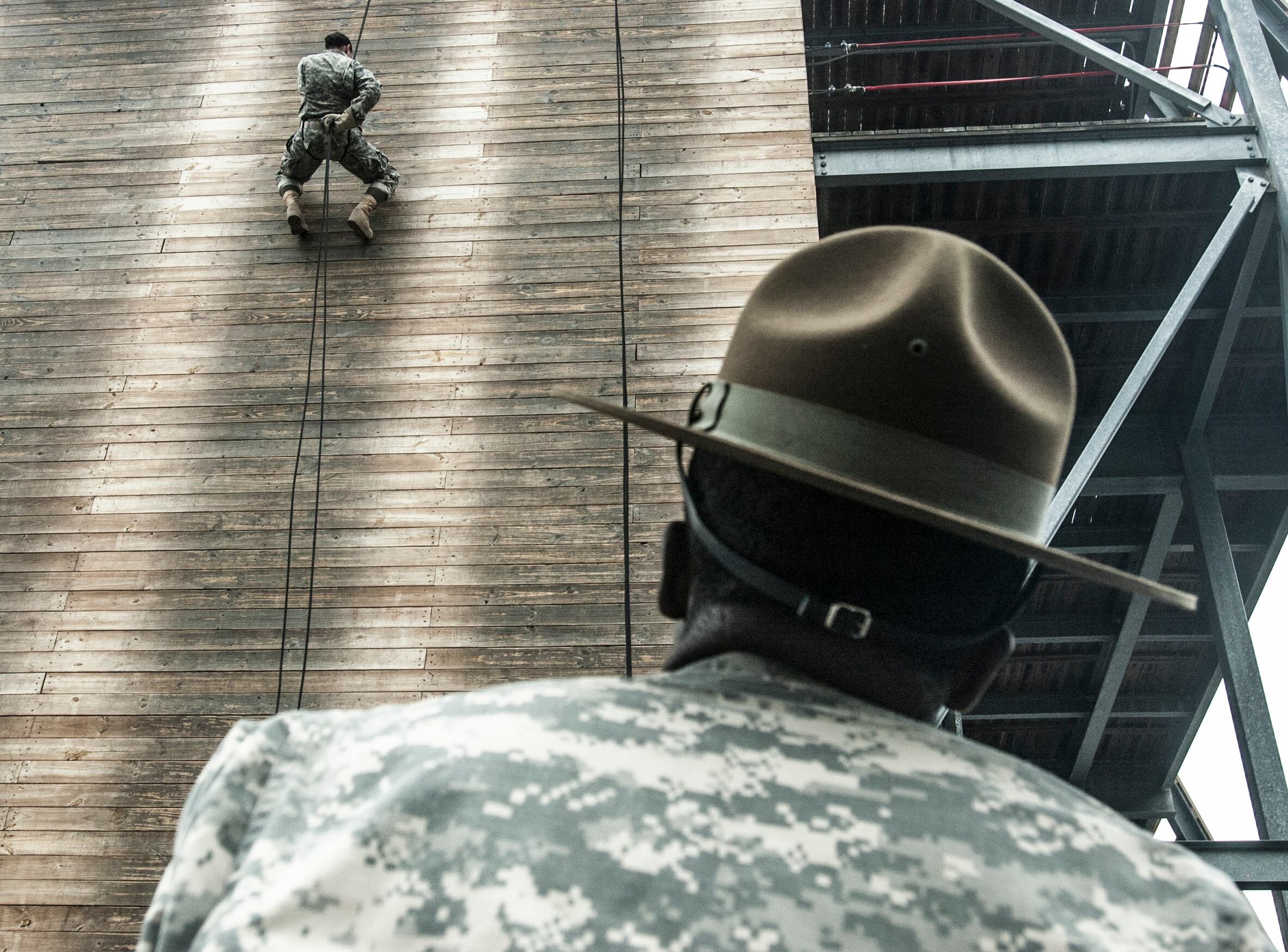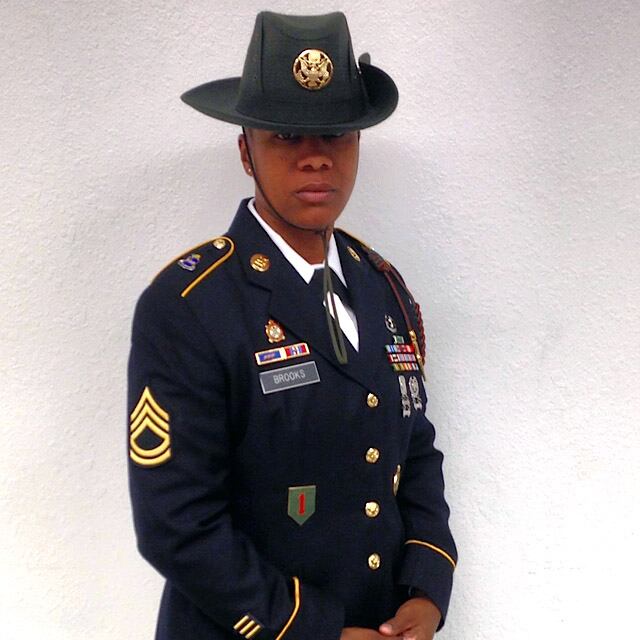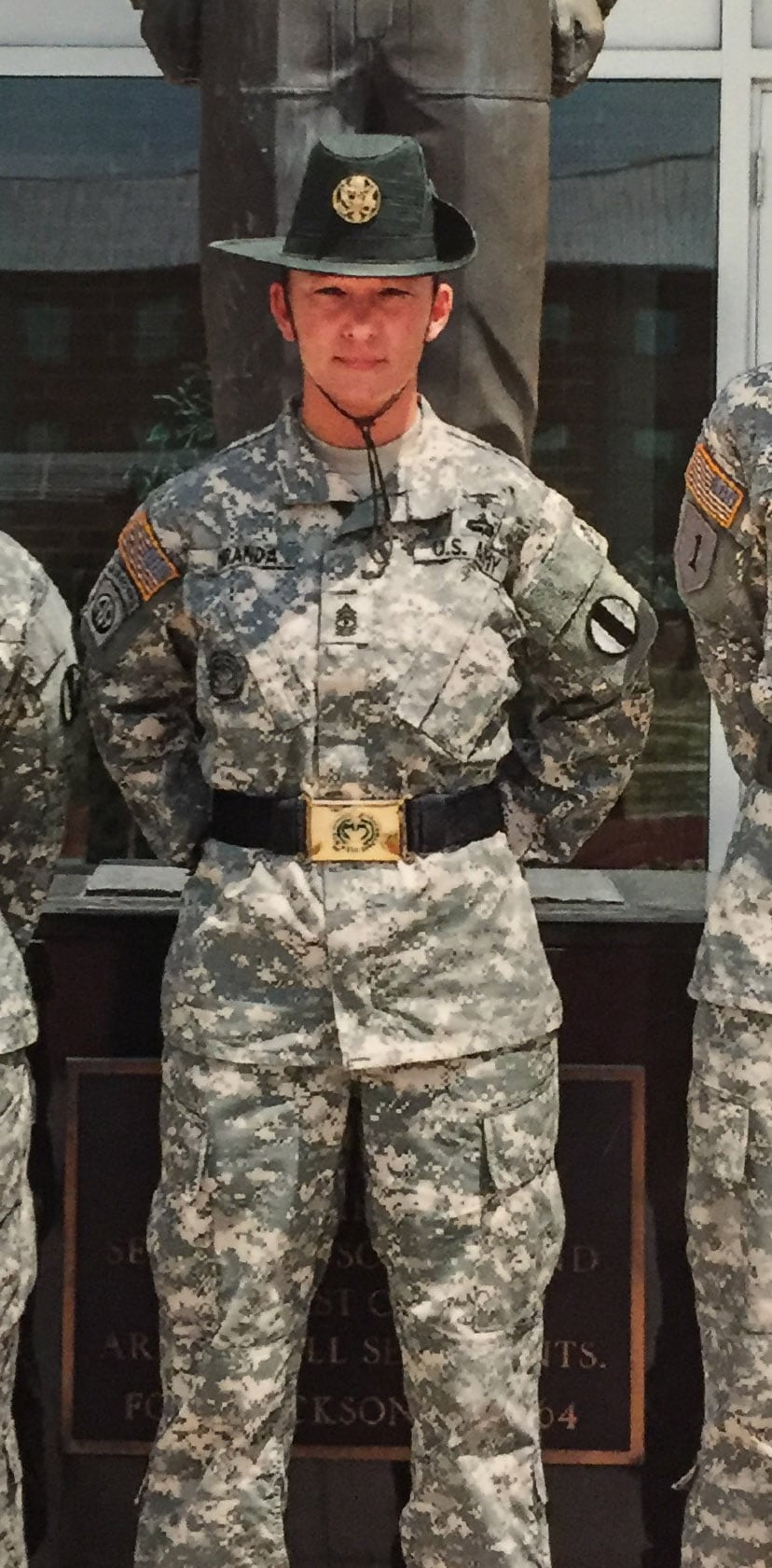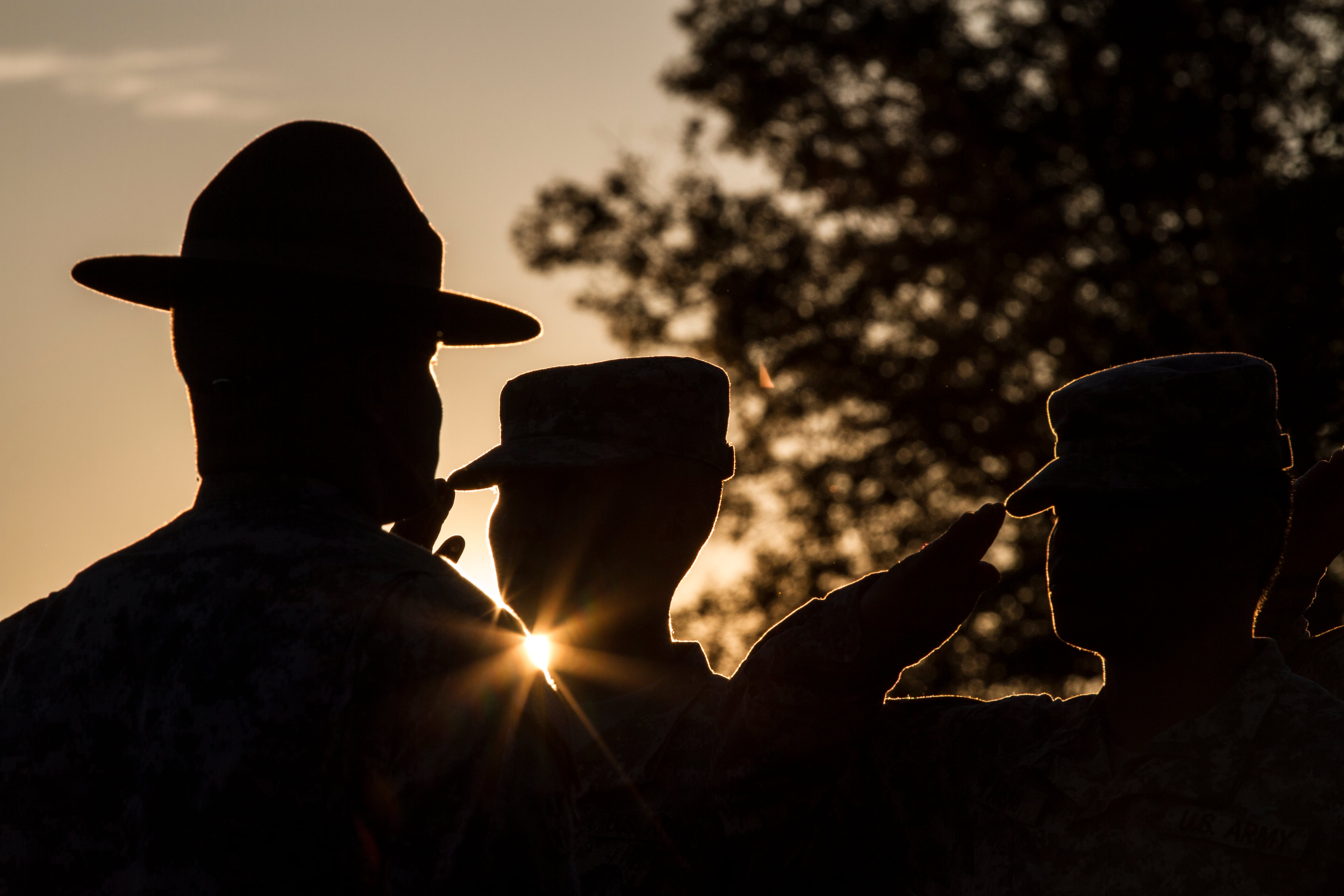The Army is looking for hundreds of drill sergeants to serve on active duty and in the Army Reserve.
The search is two-pronged: the Army needs more female drill sergeants as it prepares to open more jobs to women and tries to recruit more women into the service, while the Army Reserve only has 60 percent of the drill sergeants it needs.
As many as 1,274 authorized positions — active and Reserve — are unfilled.
The Army is looking for more female drill sergeants as it prepares to open more jobs and tries to recruit more women into the service.
"The Army is looking for a few good trainers," said Command Sgt. Maj. Lamont Christian, commandant of the U.S. Army Drill Sergeant Academy. "We don't have the requisite number of female drill sergeants in the formation to represent the population."
As of October, the Army had filled 96 percent of its male drill sergeant positions but just 83 percent of its authorized female drill sergeant positions, said Sgt. Maj. Edward Roderiques, the deputy commandant of the academy. That's 1,996 male drill sergeants assigned out of 2,088 authorized positions, and 437 female drill sergeants assigned out of 524 positions at the Army's four basic training sites, he said.
"We're pulling [qualified candidates] from the same pool everyone else is," Christian said. "It's a challenge competing with the other [commands] that are selecting the same quality NCOs without issues in their background that prevent them from being in positions of trust and authority."
The Army Reserve currently has 1,665 drill sergeants assigned. It is authorized as many as 2,760.
The component is "always looking" for solid noncommissioned officers, whether they're separating from the active Army or already in the Reserve, who want a new challenge, Roderiques said.
Serving as a drill sergeant was "the most rewarding job" of her entire career, said Sgt. 1st Class Danielle Brooks, who is now a drill sergeant leader at the academy, tasked with training future drill sergeants.

Sgt. Augustine Koomson, a drill sergeant for the Reserve, observes combat training at Fort Jackson S.C. The Reserve is looking to fill gaps in its drill sergeant ranks.
Photo Credit: Satomi Mack-Martin/Army
"It is also the most humbling job," she said. "You have 60 warriors in your platoon, and they come to you, and all their eyes are looking at you for guidance, looking at you to teach them something."
It is gratifying to watch the trainees grow into soldiers and guide them through to graduation, Brooks said.
"It makes you feel you've accomplished something, and you're part of something bigger," she said. "Soldiers never forget their drill sergeants. You have to decide what kind of drill sergeant you want to be. Do you want to be an outstanding drill sergeant, or do you want to be a dirtbag drill sergeant?"
Drill sergeant duty isn't for everyone, Christian and Roderiques acknowledge.. But the job known for its punishing hours also has its perks.
For those who can make the cut, the assignment offers gratification, special duty pay worth $300 a month, and extra consideration when you're up for that next promotion.
During the last round of promotion boards, NCOs with drill sergeant experience were 15 percent to 33 percent more likely to be selected, Christian said.

Sgt. 1st Class Danielle Brooks, a drill sergeant leader.
Photo Credit: Courtesy Danielle R Brooks
The numbers vary by grade and MOS, but this fiscal year, former drill sergeant E-6s were 33 percent more likely to be selected for promotion to E-7, while former drill sergeant E-7s were 15 percent more likely to be selected for promotion to master sergeant, as compared with their peers without drill sergeant experience, Christian said.
Regardless of the perks, a soldier must have a passion for the job, Brooks said.
"If your heart is not into taking care of soldiers and being what right looks like, then don't become a drill sergeant," she said. "If you're motivated, and you're dedicated to inspiring and motivating and teaching people how to be even better than what they already are, then absolutely be a drill sergeant."
It's fairly typical for the Army to have just 83 percent of its required female drill sergeants, whether it be because of natural attrition, injuries or discipline issues, Christian said.
But as the Army opens more military occupational specialties to women — it just this year opened combat engineer and certain field artillery jobs — the demand for female trainers will increase, Christian and Roderiques said.
A Defense Department decision is expected by the end of the year about whether the Army will open its infantry, armor and special operations positions to women.
"The more female soldiers get integrated into different MOSs and job fields, the more the demand is going to be for female noncommissioned officers as trainers," Roderiques said.
First Sgt. Heidi Miranda is the chief instructor at the Drill Sergeant Academy. A combat medic by trade, she was a drill sergeant from 2007 to 2010. She returned to the academy about 18 months ago.
"The main reason I wanted to be a drill sergeant, coming up in the military, the units I was in didn't have a lot of strong female leaders or female soldiers, period," Miranda said. "I didn't have a lot of females to look up to."

First Sgt. Heidi Miranda is the chief instructor at the Drill Sergeant Academy.
Photo Credit: Courtesy of 1st Sgt. Heidi Miranda
It's important for strong, female role models to set the example for younger soldiers, Miranda said.
In basic training, a typical company will have about 240 soldiers split into four platoons of 60 trainees, Roderiques said. Each platoon should have three drill sergeants.
"Ideally, you want at least one female drill sergeant per platoon, because you're going to have females integrated in all of the platoons, but the numbers don't bear that out," Roderiques said.
Female drill sergeants serve as mentors for female trainees, Christian said.
"When a soldier arrives as a civilian and can place eyes on a noncommissioned officer who happens to be a female, who's there as a trainer, immediately they can try to aspire and be like that person," he said. "The mere presence of a female noncommissioned officer being able to demonstrate she is just as capable as a male counterpart and just as successful, you've got role-modeling taking place, you have mentoring taking place."
Brooks, who served on the trail for two years before moving to the academy, fondly remembers her own drill sergeants — one male, one female.
"They were always there, they were there when we woke up, they trained us, they mentored us, they chewed us when we needed it, they took care of us," she said. "They were someone that made you want to follow them, someone you want to emulate."
Her female drill sergeant was a "very strong" woman, Brooks said.
"When she spoke, you listened. When she asked you to do something, you moved with a purpose," she said. "For me as a young soldier, it motivated me to do better. She was out there leading. Anything they wanted us to do, she always demonstrated it for us and expected us to execute."
Army Reserve drill sergeants are vetted, selected and trained the same way as active-duty drill sergeants. After they're certified, they serve as regular drilling soldiers, so they serve one weekend a month, two weeks a year. They must re-certify as drill sergeants every 36 months, Christian said.
Reserve drill sergeants are authorized to receive special duty assignment pay, like their active-duty counterparts, during their monthly battle assemblies and annual training. The special pay is prorated over the pay period, Christian said. For a monthly drill period, the prorated extra pay is $40, Roderiques said.
During a typical drill weekend, Army Reserve drill sergeants might go train other Reserve or National Guard units or work with ROTC cadets.
"The best units typically get out of their reserve center and find opportunities to go train somebody else at something, wherever the leadership and staff of those units can creatively put together in order for those drill sergeants to keep their skills sharp," Roderiques said.
During their summer annual training, these drill sergeants will mostly spend it at Army training sites. They will serve alongside their active-duty counterparts to bolster the training capacity as summer is when the Army sees its largest number of trainees.
Reserve drill sergeants also are called upon if the Army needs to expand its training centers, just as it did during the height of the wars in Iraq and Afghanistan, Roderiques said.
"During the Iraq surge, we were in a period of growing the Army, and it couldn't have been done without Army Reserve drill sergeants being there," he said. "Their true wartime mission is to be there and ready to mobilize and expand the training base."
In addition to regular reservists, there also are opportunities for Army Reserve Active Guard and Reserve soldiers who want to be drill sergeants, Roderiques said.
Those billets are "particularly challenging to fill" because the only AGR positions are at the Drill Sergeant Academy, and drill sergeant leaders, who are tasked with training new drill sergeants, must have previously served as drill sergeants themselves.

Serving as a drill sergeant is a real boost to your promotion potential, Army officials say.
Photo Credit: Sgt. 1st Class Brian Hamilton/Army
Part-time Reserve drill sergeants can always endeavor to become an AGR soldier and fill one of those positions, Roderiques said. But the academy also is encouraging strong-performing AGR noncommissioned officers to apply.
"The right NCO who successfully passes the vetting process, we will train them, [move] them to Fort Jackson, allow them the requisite amount of time on the trail, and return them to the Drill Sergeant Academy as a drill sergeant leader," Roderiques said. "It's an opportunity to make a strategic contribution."
To attract more volunteers, the Drill Sergeant Academy conducted a video campaign through Training and Doctrine Command, and is actively reaching out to the force and talking to commanders about the opportunities available to qualified soldiers, Christian said.
"In the past, it was considered taboo to take on a TRADOC assignment because the message was you needed to deploy, that was how you demonstrated promotability," he said. "That has changed. The message is that drill sergeant assignment, male or female, is an assignment of choice during this period of training the Army for war."
The Drill Sergeant Academy at Fort Jackson, South Carolina, trains 1,300 to 1,400 drill sergeants a year. Each drill sergeant candidate undergoes strict screening before they are able to move on to the nine-week training.
Drill sergeant duty is for two years, and NCOs have the option to extend for a third year.
Soldiers who want to volunteer to serve on the trail can call their career manager or use the Assignment Satisfaction Key, an online Human Resources Command program that allows soldiers to view and update assignment preferences and personal information.
The information in the ASK is used by assignment managers and professional development NCOs to match a soldier's preferences against Army requirements.
To qualify to be a drill sergeant, candidates must have completed the Basic Leader Course, formerly known as the Warrior Leader Course, and infantry NCOs must have 18 to 24 months of rated squad leader or section leader time. Soldiers must be able to pass a background check, and those who are on profile can only have restrictions for hearing or vision.
The requirements also call for candidates to have a General Technical score of 100, or they can apply for a waiver down to a score of 90. However, Christian and Roderiques said soldiers who don't have those scores but are otherwise qualified should still apply.
"We're encouraging NCOs, regardless of their GT scores, to volunteer to be a drill sergeant," Roderiques said.
Christian agreed, adding that the soldier's branch will determine whether he or she is suited for the job.
"The branches will not be using [GT scores] as a screening device," Christian said.
In addition to the requirements on paper, drill sergeant candidates should be adaptive and flexible, willing to work as a member of a team, able to speak in public, and resilient, Christian said.
"This is a work environment that will try your patience as an NCO," Roderiques said. "The hours are very long, family separation is constant, these young warriors will try your patience at times, and your frustration level can rise very quickly. You can't overstate the necessity for a noncommissioned officer to just be a resilient person in that position."
Soldiers who serve on the trail will return to their units as better and more capable NCOs, Christian said. Drill sergeants master training, personnel and time management skills that will serve them well into their careers, he said.
The drill sergeant experience is "absolutely what you make of it," Miranda said.
"If you focus on those young soldiers, it's going to be amazing," she said. "It's going to elevate your ability as a noncommissioned officer. You're just going to be a better coach, a better trainer, a better NCO. For any NCO that hasn't considered it, take it into consideration. No matter how much experience you have in the Army, you can grow from it."
Michelle Tan is the editor of Army Times and Air Force Times. She has covered the military for Military Times since 2005, and has embedded with U.S. troops in Iraq, Afghanistan, Kuwait, Haiti, Gabon and the Horn of Africa.





